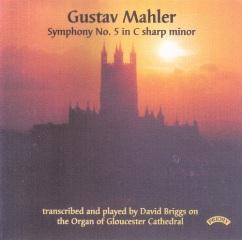Mahler - Symphony No. 5 (Transcribed for Organ) (1999)
Mahler - Symphony No. 5 (Transcribed for Organ) (1999)

01. Trauermarsch 12:32 02. Strurmisch bewegt 14:15 03. Scherzo 18:10 04. Adagietto 9:34 05. Rondo — Finale: Allegro 17:05 David Briggs – organ
Organ transcriptions of nineteenth century orchestral music are seldom subtle affairs, and you need only think of the ludicrous arrangements of Wagner's music on Anthony Newman's 1975 Organ Orgy album to know how misguided such attempts can be. Yet in spite of its unlikely prospects, David Briggs' reworking for organ of Gustav Mahler's Symphony No. 5 in C sharp minor is not a vulgar travesty. Even though it has a few moments that strain credulity (if not the performer's arms and legs), this transcription essentially works as a virtuosic organ symphony. Briggs has a fine sense of Romantic registration and he employs the stops of the Gloucester Cathedral organ in rich combinations, not unlike the colors one finds in the organ works of Saint-Saëns, Widor, or Vierne, and which work surprisingly well for Mahler. Of course, even with a lavish array of stops, the organ cannot reproduce the finely shaded dynamics and incisive orchestration of the symphony, and many of Mahler's wispy, swelling, throbbing, or biting sonorities are reduced to flatter and less effective timbres, or just bypassed for the sake of simplification. Yet Briggs' intentions are honorable, and he tries to simulate as much of the orchestration and original textures as possible on four manuals and pedals, and he succeeds in many ingenious passages. It takes a little time to adjust to hearing this familiar masterwork in a different guise, but once past initial misgivings over the strangeness of the Trauermarsch or the awkwardness of the Sturmisch bewegt, the listener can begin to get quite comfortable with the transformation and even accept the Scherzo and the Adagietto as well-suited to this instrument; by the Rondo-Finale, Mahler's dazzling fugal textures begin to sound as if they were conceived for organ, rather like some of César Franck's most ecstatic counterpoint. While this elaborate re-creation of Mahler's Symphony No. 5 is generally successful and strangely likable, it is definitely not recommended as a first choice for newcomers; if you've never heard it before, listen to the orchestral original first. But for those who know the piece well, Briggs' CD is much more than a novelty album and worth at least one fair hearing. ---Blair Sanderson, Rovi
Before considering David Briggs' transcription of Gustav Mahler's Symphony no. 5 or his performance of it, it is important to note that Briggs is a British organist playing a British organ. Transcribed for and performed on a French organ, the result would be more "symphonic," as French organ-builders have leaned much more toward imitating the sounds of instruments and voices. The organ of Gloucester Cathedral, however, is a 20th-century rebuilding of what is essentially a 17th-century instrument. The effect on Briggs' transcription is that rather than attempting to produce an orchestral sound, he reconceived the work to sound well on the organ.
All of that said, Briggs has done an admirable job of carrying off Mahler's symphony in his own medium--although the specific sounds are different, he has captured the work's essences. His playing is superb, from the smallest pianissimos of the Adagietto to the full-out, both-hands-both-feet finale. Expect an organ symphony and you're in for an engaging listen; expect an orchestral symphony and you'll be disappointed...until you listen again! ---arkivmusic.com
download (mp3 @320 kbs):
salefiles yandex 4shared mega mediafire zalivalka cloudmailru uplea
